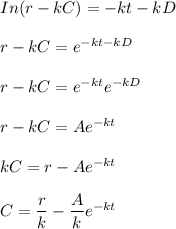Answer:

 ,thus, the function is said to be an increasing function.
,thus, the function is said to be an increasing function.
Explanation:
Given that:


Taking integration on both sides ;




here;
A is an integration constant
In order to determine A, we have






Thus:

2. Assuming that C0 < r/k, find lim t→[infinity] C(t) and interpret your answer

The equation for C(t) can be rewritten as :

Thus; the function is said to be an increasing function.